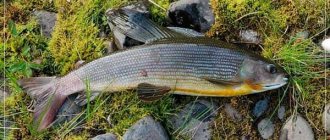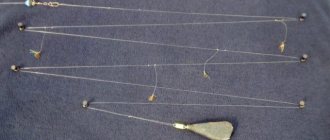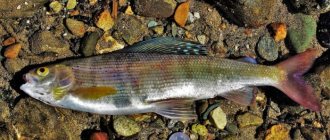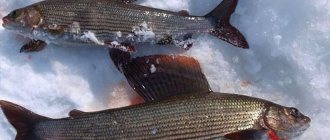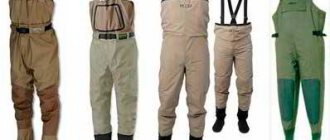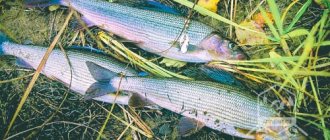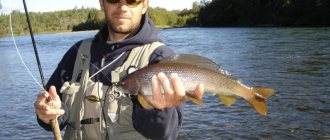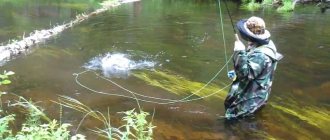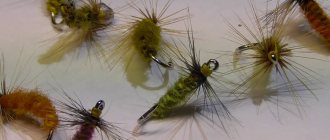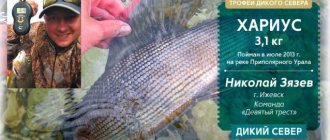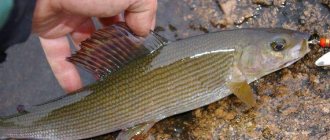Truly picturesque places in the northern latitudes are inhabited by no less amazing representatives of the underwater world. Grayling is a small fish whose meat is highly valued in the cuisines of many countries around the world. The species lives in small flowing reservoirs, as well as large rivers, occupying areas with fast currents and rapids. Grayling is a predatory fish; it can be caught with a spinning rod, fly fishing and a float using a Tyrolean stick.
The principle of operation of the Tyrolean stick
The classic Italian equipment is an elastic plastic tube 10-12 mm thick. There is a lead weight at the bottom of the stick, and at the opposite end there is a loop for attaching to the main line of the fishing rod. The equipment can be called an underwater float, because when it gets into the water it takes a vertical position. Depending on the characteristics of the reservoir, a model with certain weight and size parameters is selected.
Other fishermen compare the Tyrolean stick with a special sinker that acts as a limiter. Thanks to the properties of the Tyrolean, it is possible to hold the lightest baits at the bottom, despite the buoyant influence of the current. Most often, fly fishing flies are used as an artificial bait when fishing with a tackle called a Tyrolean stick. Less often, anglers use jigs and spinners.
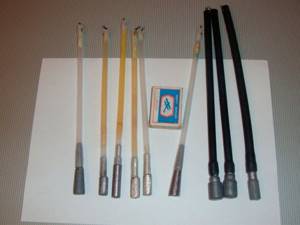
Photo 1. Types of Tyrolean sticks.
Fishing place
Grayling is very shy, so you should move along the shore without making too much noise. The fish prefers to stay in small schools, away from the shore and in a strong current. Most often, this small predator is found in small rivers, although it is also common in larger flowing waters, such as the Yenisei and Akhtuba.
A representative of the ichthyofauna can feed from the surface, where fly fishermen are accustomed to catching it, but, as a rule, a bite of a heavier trophy should be expected in the water column or at the bottom. Catching grayling with a Tyrolean stick helps in deep-water areas of the reservoir. Having selected the required weight, you can examine pits even with the strongest current. Don’t forget that to catch the nimble grayling you will need a small catch, which is convenient for getting the caught prey out of the water. The fishing location directly affects the final result of fishing, so the angler should always remember that spinning fishing is a sporting activity that requires constant movement around the water area and searching for an active predator.
Fishing rod equipment
To catch fish using a Tyrolean stick, a spinning rod is used. Each element has certain requirements.
- The rod must be rigid enough so that every touch of the fish is transmitted to the spinning rod in a timely manner. The knock on the hand very quickly becomes clear even to novice anglers. The length of the rod should correspond to the size of the river. A universal option would be a 2.4-2.7 m stick with a test load of up to 100-120 g. To prevent your hand from getting tired from fishing, it is better to give preference to lightweight carbon fiber models.
- The main requirements for a reel are high quality and a spool size of at least 2500.
- The role of the main fishing line is most often played by braid. It does not stretch, which makes it possible to keep the equipment under control. The diameter of the cord is selected from the range 0.12…0.18 mm.
Attention: the thicker the main line, the faster the bait swims. The fish may simply not notice it.
Wiring
For fishing with a Tyrolean stick, preference is given to slow, measured movement of the bait in the water column. In some cases, slow retrieving may be accompanied by swinging of the rod's hook with a short amplitude.
The method of randomly moving the bait using the river current is often used. The choice of wiring technology depends on the bait used for fishing.
A special feature of the Tyrolean stick is the ability to deliver light bait to great depths.
The choice of wiring when fishing for grayling with a Tyrolean stick is limited: they use twitching or regular wiring, depending on the bait. Additionally, it is worth taking into account the nature and place of fishing. Twitching when using a Tyrolean stick is smoother, which allows you to catch even sluggish autumn fish.
Having chosen a promising area of the reservoir, make a long cast to the opposite bank. Retrieving begins after the tip of the rod calms down after the “Tirol” hits the bottom. It can be either uniform or twitching. For example, grayling bites well on bait held evenly and synchronously with the current.
Even during a pause, the stick will continue to oscillate due to the strength of the current, and at the same time the bait will continue its movements that are attractive to the fish. The bait does not touch the bottom, so the chance of getting a hook is small.
Of course, sometimes there are cases when grayling calmly leads the bait all the way to the shore and only then grabs it right in front of the fisherman.
Casting the tackle is done at an angle of 45º upstream. After splashing down the Tyrolean stick, the angler must close the line arc and immediately pick up the slack in the braided line.
The line between the tip of the rod and the tirol should be taut like a string. This tension must be maintained by winding the braid.
After the tackle reaches the angler, reeling can be stopped. In addition, during the retrieving process, you can not only statically reel in the fishing line, but also play along a little with the tip of the rod, like a microjig.
Sometimes grayling takes on a static retrieve, that is, they cast it, picked up the slack in the braid and then, reeling it in, aligned the tackle with it and it went downstream, without reeling in. Sometimes the grayling doesn’t want to peck at anything, and this is where playing along with the tip of the rod often helps.
This method was taught to me by a fisherman on the banks of the Yenisei, unfortunately I don’t know his name. Nevertheless, this method of wiring often helped me out in bad bites.
I hope that I explained it clearly, at least I didn’t hide anything, I told everything as it is. Good luck in mastering this exciting method of catching grayling. Well, watch the video about the Tyrolean stick.
Installation of equipment
When installing a Tyrolean stick on a fishing rod, you should take into account its behavior in water. Since a heavy load lowers one end of the rig to the bottom, the stick takes a vertical position. The bait is connected to the upper part of the equipment and does not fall when fishing to the bottom.
Installation of the Tyrolean is carried out in one of two ways.
- Tying the rig at the end of the main line is reminiscent of rigs with an end sinker. One or more leashes are attached in front of the stick.
Important: the length of the leash must be such that when equipped, the hooks with bait do not extend beyond the Tirolka.
- In order not to negate the advantages of Italian equipment, the baits used should be very light and the hooks small. In addition to artificial flies, you can also use natural baits such as bloodworms, caddis flies, maggots, and grasshoppers. Using a Tyrolean stick as an end sinker is best suited for catching white fish and small sailors.
- An alternative option for mounting a Tyrolean is the Carolina equipment. With this configuration of tackle, you will need a special mount, which is used in match floats. The weight is removed from the Carolina rig and the Tyrolean weight takes its place. This option is characterized by stable behavior on rivers with strong currents. Thanks to the weighted equipment, it becomes possible to fish with silicone baits on long leashes (up to 0.5 m). The bait will behave like a real fish even with the rig in a static position. The fisherman needs to perform slow stretches and wait for the moment of bite. The symbiosis of Carolina and Tyrolean rigs allows you to hunt for large pike perch, perch and pike.
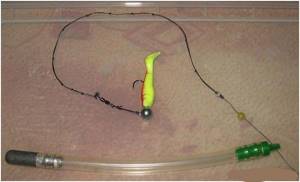
Photo 2. Tyrolean stick in Carolina rig.
How to catch?
The catching technique depends on the character of the grayling and its behavior in its native element. This is a predatory fish with developed vision. The grayling simply follows the bait and grabs it almost right next to the shore. The catcher is required to support the game to the coast.
Reference. Experienced fishermen advise using a twitching liner or even reeling when fishing so as not to miss the prey.
You have to look for fish in the streams of the river at a distance from the shore. To make long casts, a weighted tyrole is used. But heavy tackle reduces sensitivity. Therefore, deep sections of rivers behind rocky drops are explored for fishing. The bite begins after the fish swims out of the deep waters onto the shallows.
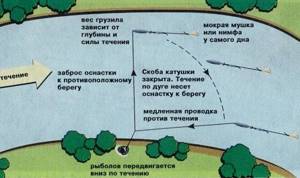
The Tyrolean is universal and suitable for using various fishing techniques. The following eyeliner methods are available with the ballerina fisherman:
- uniform;
- jerk (twitch);
- with dragging along the bottom;
- with tosses in one place;
- stepwise, with small pauses.
It is better for the fisherman to cast the bait under the opposite river bank. When the jumper comes into contact with the bottom of the reservoir, fishing begins (with jerks or evenly). You can also provoke the fish to bite by moving the bait downstream. To do this, the fisherman uses stops with the ballerina tapping on the bottom.
Tip: Grayling fishing takes place on rocky rivers with a current. The catcher should be prepared that the ballerina will get stuck behind the natural obstacles of lakes/rivers (stones or snags).
Homemade Tyrolean stick
It is not always possible to choose the ideal equipment when fishing in the river. Therefore, fishermen successfully make Tyroleans with their own hands for specific conditions. The main characteristics of the Tyrolean stick equipment are weight and size.
To make a Tirolka, you need to select the following materials:
- transparent tube;
- a piece of lead;
- a piece of wire 0.5 mm thick;
- wooden block.
The manufacturing technology is as follows.
- At the first stage, you should make a loop to attach the equipment to the main fishing line. To do this, you can use a nail and pliers. The ends of the wire are bent to better fix the loop in the tyrolean.
- A layer of epoxy glue is applied to the loop, after which it is inserted into the tube. After drying, the remaining glue is removed with a file or sandpaper.
- Using a drill, 3 holes are made in the block; their diameter should be the same as the internal size of the tube.
- Molten lead is poured into the formed mold. As soon as the weight has cooled, it is removed from the wood. Now, using pliers, excess lead is removed, the exact mass is determined using scales.
- The required amount of lead is inserted inside the tube, and a little glue is first applied to the load.
- To seal the tube, you can use glue or heat shrink.
Thanks to this simple technology, many types of Tyrolean rigs can be made, differing in length, weight and color. All that remains is to select the equipment for a specific river and cast the bait.
Wiring selection
In the fishing technique of every spinning player, there are favorite animations of baits. The choice of specific wiring depends on the mood of the fish, the fishing location, the strength of the current and the type of bait. The Tyrolean stick is a universal tackle in this regard. It can carry out several types of postings:
- uniform or dragging along the bottom;
- jerk (twitch);
- on-the-spot tosses;
- step animation with small pauses.
In a strong current, you can leave the equipment stationary, in which case the current does the wiring for the angler. In addition, drift fishing brings good results. To do this, the bait is thrown up the stream under the opposite bank, and the flow of water pulls it along the bottom, thereby moving the bait and catching promising points.
Most often you have to fish on small mountain rivers with rapids and a strong stream. In such places, the water is abundantly saturated with oxygen, and the fish feel cheerful in it. Based on these beliefs, you should start fishing with active retrieves, and if there are no bites, then you need to change tactics.
Grayling fishing is an exciting activity. The inaccessibility of rivers often preserves the population of this valuable species. Having fished in wild places, on small rivers and wide water areas, the fisherman feels unity with nature and he wants to return there again and again.
intellifishing.ru
Where and when to catch grayling using a Tyrolean stick
The Tyrolean stick can be used all year round when fishing for grayling. Most often, this fish is found in places where, behind a rocky rift, the depth of the river can quickly turn into a shallow. If you find such an area, cast the bait to the opposite side. There is a better chance of catching grayling far from the shore, in areas with strong currents that make their way between the stones. It happens that he can chase the bait until he hits your feet, but such cases are quite rare.
Subscribe to
our channel in Yandex Zen
In what cases is Tyrolean appropriate?
By using such an accessory, you can combine the two most popular methods of catching fish: spinning and bottom. It is especially loved by fans of spinning rods, since the bait on the hook, accompanied by a stick, allows you to display the movements of small fish in the water. The nozzle seems to be gliding along the bottom, and not just crawling, as in other fishing equipment.
Using a wobbler together with a Tyrolean allows you to make leashes in which the likelihood of snagging is reduced. The small weight of the stick facilitates casting the bait over long distances. In addition to wobblers, you can install any other attachments on the hooks, both plant and animal origin. The principle of using equipment is similar to the method with retractable leashes, but it is more accurate and reliable, and fishing with such equipment is more comfortable. Other advantages of the gear are:
- effective supply of bait or bait at shallow depths;
- use not only with a spinning rod, but also with a regular telescope rod;
- the equipment does not get tangled or overlap.
To learn more:
The subtleties of fishing with a diverting leash in the current in the fall
The disadvantage of the design is the overall limitations and a kind of “unmasking”.
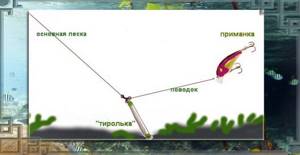
Tyrolean stick - the absence of hooks and the basis for success in fishing on mountain rivers
One of the most interesting trophies for anglers is grayling.
There are many ways to catch it, as well as baits. Due to the characteristics of the habitats and habits of the fish, light baits are often used. The size of the prey rarely exceeds a kilogram weight; mostly individuals 200-500 grams are found. A Tyrolean stick helps to cast a small bait over a long distance on grayling.
It serves as a kind of weighting agent for the equipment and is considered a type of rig with a diverting leash.
This type of fishing was invented in Europe for hunting trout in small rivers with strong currents. Casting a fly or guiding a microscopic wobbler at the required depth is achieved precisely with the help of a Tyrolean bait. Having demonstrated excellent results in trout fishing, it was decided to introduce this tackle into fishing for such fish as chub, perch, pike perch, pike and, of course, grayling.
The following types of baits can be used with its help:
- wobblers (both floating and suspended);
- silicone tips without additional shipping;
- flies, nymphs;
- natural baits (worms, larvae, beetles).
They fish for the Tyrolean fish using a spinning rod. His test depends on the weight of the sinker itself.
It is better to use cord as the main fishing line, and knit leashes from high-modulus monofilament that does not have “memory” or fluorocarbon.
The advantage of the latter lies in the refractive spectrum under water, which prevents the sharp vision of a predator from noticing the tackle, and the rigidity of the material reduces the twisting of the entire structure.
Installation of equipment
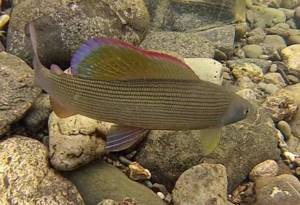
You can make a Tyrolean stick with your own hands. The length of the tube is selected according to the specific characteristics of the reservoir; it can be made of transparent vinyl chloride, and the load, as a rule, is lead.
The installation of the Tyrolean stick structure is attached with a loop to a fishing line with leashes, the length of which depends on the fish’s bite. The more carefully the grayling takes, the longer the leash is needed.
It is better to tie the hook to the leader material with a “clinch”; this knot is compact, reliable and known to almost every angler.
A loop is tied on the reverse side of the entire installation, to which the main cord is attached using small carabiners. It is worth noting that the diameter of the leader material used is an order of magnitude thinner than the main line.
You can set up the tackle correctly thanks to the Tyrolean stick pattern.
Fishing place
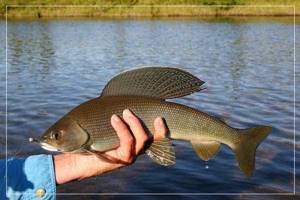
Grayling is very shy, so you should move along the shore without making too much noise. The fish prefers to stay in small schools, away from the shore and in a strong current. Most often, this small predator is found in small rivers, although it is also common in larger flowing waters, such as the Yenisei and Akhtuba.
A representative of the ichthyofauna can feed from the surface, where fly fishermen are accustomed to catching it, but, as a rule, a bite of a heavier trophy should be expected in the water column or at the bottom. Catching grayling with a Tyrolean stick helps in deep-water areas of the reservoir. Having selected the required weight, you can examine pits even with the strongest current.
Don’t forget that to catch the nimble grayling you will need a small catch, which is convenient for getting the caught prey out of the water. The fishing location directly affects the final result of fishing, so the angler should always remember that spinning fishing is a sporting activity that requires constant movement around the water area and searching for an active predator.
Wiring selection
https://www.youtube.com/watch?v=edcat2CW4Qs
In the fishing technique of every spinning player, there are favorite animations of baits. The choice of specific wiring depends on the mood of the fish, the fishing location, the strength of the current and the type of bait. The Tyrolean stick is a universal tackle in this regard. It can carry out several types of postings:
- uniform or dragging along the bottom;
- jerk (twitch);
- on-the-spot tosses;
- step animation with small pauses.
In a strong current, you can leave the equipment stationary, in which case the current does the wiring for the angler. In addition, drift fishing brings good results. To do this, the bait is thrown up the stream under the opposite bank, and the flow of water pulls it along the bottom, thereby moving the bait and catching promising points.
We invite you to familiarize yourself with: Fishing for perch with a spinning rod: in summer from the shore, boats, in spring, new items in 2021
Most often you have to fish on small mountain rivers with rapids and a strong stream. In such places, the water is abundantly saturated with oxygen, and the fish feel cheerful in it. Based on these beliefs, you should start fishing with active retrieves, and if there are no bites, then you need to change tactics.
Grayling fishing is an exciting activity. The inaccessibility of rivers often preserves the population of this valuable species. Having fished in wild places, on small rivers and wide water areas, the fisherman feels unity with nature and he wants to return there again and again.
The Tyrolean stick can be considered a unique fishing device that every fisherman should have. Tyrol is used for slow retrieve in reservoirs with dense vegetation and a rocky bottom. It should also be used in places where other gear may get tangled, because when used, the risk of snagging is quite small.
The Tyrolean stick is made from an ordinary plastic tube, which is hollow inside. A sinker is attached to it at one end, and on the other there is a special hole for fishing line. When cast into the water, it is located in a standing position and holds the bait at a short distance from the bottom of the lake. It is necessary to ensure that the walls of the tackle are of medium thickness. Otherwise, the mass of this device will be very large.
The scope of application of the Tyrolean is quite large; it is used:
- for fishing with live bait;
- for fishing with flies and various jigs;
- for fishing with a moving wobbler;
- for fishing with foam rubber or silicone baits.
The mass of the Tyrolean stick ranges from 10 to 70 grams and directly depends on the maximum depth of the lake or the speed of the current.
The main advantages of Tyrolean are as follows:
- absence of snags on algae, stones and various debris at the bottom of the reservoir;
- versatility in use, which allows it to be used together with spinners and other baits;
- long casting range when using the lightest baits;
- very easy assembly and simple wiring;
- possibility of making it yourself;
- low price.
This gear has only one drawback. In case of a snag, the Tyrolean stick along with the bait will remain at the bottom of the reservoir.
This type of fishing equipment has recently become very popular, so the “Tyrolean stick” is increasingly used by spinning anglers as an alternative to a retractable leash.
It is most often used for fishing with small bait, but using long casting. This bait is perfect for catching perch with a medium-sized twister.
In this case, a jig head is not needed, because it will only make the bait harder to play, and we need to achieve the greatest naturalness.
Within the framework of this article, we will outline the features of fishing for grayling using the Tyrolean stick rig.
Even a beginner can rig a Tyrolean stick. There is no need to do anything complicated here. Moreover, this type of rig is not much different from the Carolina rig. It’s just that in this case, a stick will be used instead of a load.
A stick is threaded through the main line through the top ring. Next comes a bead, which is a stopper that prevents the stick from going lower to the bait. After the bead, you can and should tie a fluorocarbon leash to reduce the visibility of the fishing line near the bait, otherwise the fish may get scared and not bite.
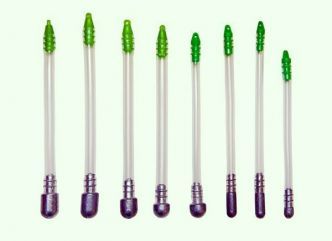
When fishing for pike, such a leash is not suitable. The sharp teeth of the river queen will quickly break the tackle - a special powerful leash is needed here. They are usually commercially available and are usually made of metal.
We suggest you read: Grayling fishing in autumn. Tackle for grayling in autumn
The Tyrolean stick is good for catching predators, for example:
- perch;
- pike;
- pike perch;
- grayling
When catching grayling with a Tyrolean stick, the chances of catching the load among the stones are significantly reduced. Moreover, while using this equipment, you can take any light-weight bait (tiny flies and twisters without a weight head).
In this case, it is recommended that you install one or several short leashes that are tied in front of the stick at some distance. Moreover, the total length of the wires should not be greater than the length of the tube itself. Bait should be chosen with the smallest weight. Otherwise, there is no point in making this kind of equipment.
In water, the Tyrolean pipe should take a vertical position. After all, its main purpose is to hold the bait in the bottom layer of the reservoir.
A very interesting method of installation, similar to the standard equipment of the Tyrolean stick, is fishing with floating wobblers.
In this case, the Tyrolean stick not only moves freely along the fishing line to a special bead fastener, which attaches the leash with the bait, but is also limited on the opposite side by the same bead.
Only in this case the bead is at a fixed distance from the stick.
This installation is ideal for a floating wobbler. In this case, the bait unhinderedly goes deeper into the water column, reaching the bottom surface. Then it immediately floats up to a height determined by the angler from him.
The distance between the main line bead and the clasp is determined by rotating the reel handle when the wobbler stops above the bottom. One of the methods of rigging with a wobbler is also the installation of a Tyrolean stick using a swivel.
It is worth noting that the length of the leash, including the stick itself, must necessarily be greater than the depth of the wobbler. This is done to prevent snagging on the bottom, including to avoid scraping the blades along the bottom.
Sometimes it is necessary to assemble the Tyrolean rig so that the stick is at the end of the entire rig, and the bait is on a leash in front of it.
This article will talk about how to catch grayling using a Tyrolean stick. This is another way to catch this type of fish.
How to make a Tyrolean stick for catching grayling with your own hands
Tyrolean sticks, which are sold in stores, often do not suit anglers due to their weight or dimensions. But there is no need to be upset. It’s very easy to make this simple tackle yourself; you don’t need any special equipment or skills. The whole process takes literally a few minutes. You will need a small piece of thin-walled hollow PVC pipe (the thinner its walls, the better, because this reduces the weight of the product itself). On one side, you need to place a weight on the waterproof glue - it could be lead, but it is better to take a regular bolt (screw) corresponding to the diameter of the tube cross-section.
You can use, for example, cocktail straws. If they have a corrugated part, then using a syringe you can “suck” a molten alloy of tin, lead and bismuth into it, which will hermetically close one end of the tube. At the other end, drop glue directly into the tube and press it about 1 centimeter using pliers, a vice or a regular clothespin. We fix it in this way until the glue sets. Then, with an awl, you need to pierce a hole in the compressed part and thread a carabiner through it, that is, a clasp for attaching the float, or a carabiner with a swivel.
Read: Peculiarities of grayling fishing in winter
